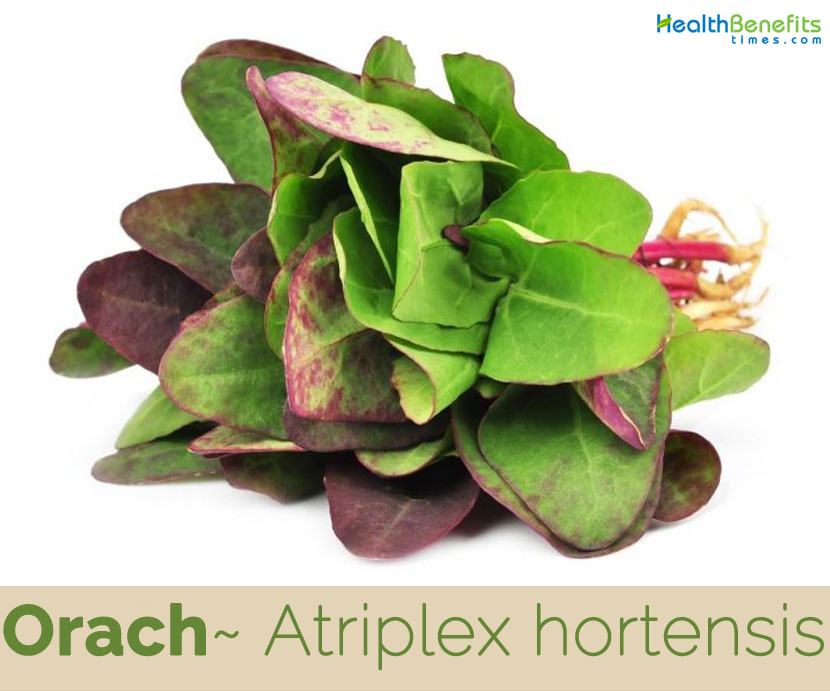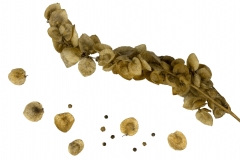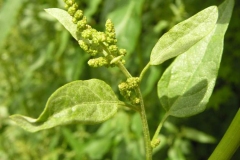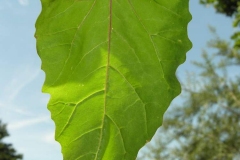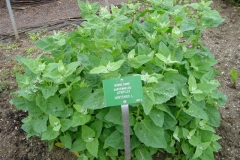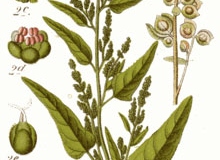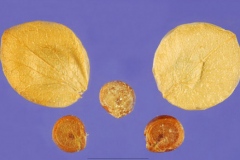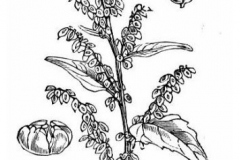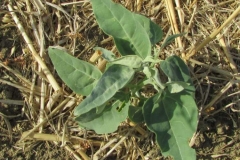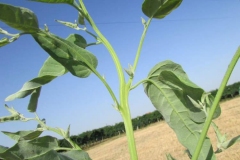| Orach Quick Facts | |
|---|---|
| Name: | Orach |
| Scientific Name: | Atriplex hortensis |
| Origin | Central Asia and widely naturalized in Canada, the United States, Australia, New Zealand |
| Shapes | Achene enclosed by fruit calyx. Calyx with two round, net-veined, entire margins |
| Taste | Salty, spinach-like taste |
| Health benefits | Cure Cancer, Boosts Metabolism, Improves Digestive Health, Boost Immune System, Improves Functioning of Kidney, Prevent Anemia, Prevent Macular Degeneration, Healthy Heart, Improves Bone Health, Weight loss, Healthy Eyes, Lower blood pressure, Provides good amounts of copper |
| Name | Orach |
|---|---|
| Scientific Name | Atriplex hortensis |
| Native | Central Asia and widely naturalized in Canada, the United States, Australia, New Zealand, whole of Europe with the exception of the British Isles and North Europe |
| Common Names | Garden orach, Garden orache, Mountain spinach, Orach, Orache, Sea purslane, Armuelle mole, Bledos moles, Garden saltbush, French spinach, Garden atriplex, Arrach, Red Orach, Butter leaves, garden arrach |
| Name in Other Languages | Albanian: Labot, laboti i kopshtit Arabic: rghl bstany (رغل بستاني) Assamese: Pahari paleng Basque: Garadaizka Bokmal: Fjellspinat, Hagemelde Bulgarian: Gradinska loboda (градинска лобода) Catalan: Armoll, Blet moll, Espinac de carn, Moll Chinese: Yu qian bo cai (榆钱菠菜) Croatian: Vrtna pepeljuga Czech: Lebeda zahradní Danish: Havemælde, Have-Mælde, Melspinat Dutch: Tuinmelde English: Garden orach, Garden orache, Mountain spinach, Orach, Orache, Sea purslane, Armuelle mole, Bledos moles, Garden saltbush, French spinach, Garden atriplex, Arrach, Red Orach, Butter leaves Esperanto: Atriplo ĝardena Estonian: Aedmalts Finnish: Tarhamaltsa French: Arroche des jardins, Arroche épinard, Epinard géant, Arroche rouge des jardins, Bonne-dame, Arroche bonne-dame, Belle-Dame, Chou d’Amour, follette Galician: Armol German: Gartenmelde, Garten-Melde, Spanischer Spinat, orache, Spanischer Salat Greek: Atríplia (ατρίπλια) Hungarian: Kerti laboda Italian: Atriplice degli orti, Bietolone rosso, atriplice Bianca, atriplice rossa, bietolone atriplice, spinacione Japanese: Akaza (アカザ), Akaza (あかざ), Akaza (藜), Oraachu (オラーチェ) Kashmiri: Vasta Haak Latvian: Darzine balandune, dārza balodene Lithuanian: Daržinė balandūnė Occitan: Armòlh, Arn blanc, Bois blanc Ossetic: Futæg (Футæг) Netherlands: Tuinmelde Northern Frisian: Guardmial Norwegian: Matmelde, Fjellspinat, Hagemelde Persian: سلمکی باغی Polish: Łoboda Ogrodowa Portuguese: Armolas, erva-armoles Romanian: Lobodă, lobodă de grădină, ştir Russian: Lebeda sadovaya (Лебеда садовая) Serbian: Bashtanka loboda (баштенска лобода) Slovak: Loboda záhradná Slovenian: Loboda vrtna, vrtna loboda Spanish: Armuelle mole, Bledos moles, Armuella de huerta, Armuelle, Cogolletes, Espinaca de Carne, Ramos de Coral, verdolaga hortense, Armoles, ceniglo Swedish: Trädgårdsmålla, Tarhamaltsa, Mållspenat Turkish: Kara pazı, hayat süpürgesi Ukrainian: Loboda sadova (Лобода садова), lutyha sadova (лутига садова) Welsh: Llygwyn yr ardd |
| Plant Growth Habit | Tall, erect-growing hardy annual plant |
| Growing Climates | Arable land, waste and disturbed ground, shingle |
| Soil | Grows well in a wide variety of well-drained soils, though rich, moisture-retentive soils give the quick growth |
| Plant Size | 0.6 m to 1.8 m |
| Stem | Erect, sparsely branched, cylindrical, green-striped, base colour yellowish or sometimes reddish. Sometimes whole plant reddish brown |
| Leaf | Smooth, heart- to shield-shaped, comparatively thin in texture, and slightly acidic to the taste |
| Flowering season | July to August |
| Flower | Small, momoecious, greenish or reddish, corresponding in a degree with the color of the foliage of the plant |
| Fruit Shape & Size | Achene enclosed by fruit calyx. Calyx with two round, net-veined, entire margins, separating leaves, 5–15 mm (0.2– 0.6 in.) wide |
| Seed | Small, black, 2–4 mm broad surrounded by a thin, pale-yellow membrane |
| Propagation | By seeds |
| Taste | Salty, spinach-like taste |
| Plant Parts Used | Leaves, fruits |
| Season | August – September |
| Health Benefits |
|
Plant Description
Orach is a tall, erect-growing hardy annual plant that usually grows about 0.6 m to 1.8 m tall according to the variety and soil. The plant is found growing in arable land, waste and disturbed ground and shingle and usually prefers wide variety of well-drained soils, though rich, moisture-retentive soils give the quick growth. Stem is erect, sparsely branched, cylindrical, green-striped, base color yellowish or sometimes reddish. Sometimes whole plant reddish brown.
Leaves
Leaves are alternate, lowest almost opposite. Blade is widely triangular, 5-25 cm long and 3-18 cm wide, green on both surfaces, slightly mealy when young. Lower leaves with sagittate or cordate base, with entire or sparely toothed margins, upper leaves with rounded base, with entire margins. Petiole is about 1-3 mm long. They are slightly acidic to the taste. Since leaves of garden orach are green but other varieties can have red or yellow-green leaves.
Flower
Orach blooms from July to August with small and inconspicuous flowers that sit in clusters on the top of the stem. They are obscure greenish or reddish, matching to a degree with the color of the foliage of the plant. Flowers are uni-sexual (dioecious), with flowers of both sexes on the same plant. The flowers are wind pollinated.
Fruits
Fertile flowers are followed by achene enclosed by fruit calyx. Calyx with two round, net-veined, entire margins, separating leaves, 5–15 mm (0.2– 0.6 in.) wide. Seeds are small, black, 1.5–3 mm (0.06–0.12 in.), surrounded by a thin, pale-yellow membrane, and they retain their viability for three years.
Varieties
There are four common varieties of orach.
White Orach
White orach is most often grown. The leaves are very pale green, almost yellow.
Dark red orach
Dark red orach has dark-red stems and leaves.
Green orach
Green orach, also called Lee’s giant orach, and is very vigorous, with a stout, angular, branching stem. The leaves are rounder, less toothed, and darker green than those of the white variety.
Copper Orach
The fourth is a copper-colored variety that is rarely grown.
Health Benefits of Orach
Health benefits of Orach include its capability to regulate the digestion of food; it can also improve the health of our kidney. It can also strengthen our immune system, and boost our cardiovascular strength. Orach can also detoxify our blood and it can prevent chronic diseases and certain types of cancer. Listed below are some of the popular health benefits of Orach
1. Cure Cancer
According to a research published in the Acta Physiologiae Plantarum Journal, orach consists of certain antioxidant compounds that may decrease the danger of cancer from developing and can also counteract free radicals that cause oxidative stress in the body’s organs and cells. For example, the high levels of anthocyanins and carotenes in orach help to reduce signs of premature aging, boost the health of your eyes, improve cardiovascular health, and even prevent certain mutations in cells that can lead to cancer. (1)
2. Boosts Metabolism
Proteins, minerals, and vitamins deposited in orach can help everything from hormonal regulation to enzymatic reactions that are essential to keep the body functioning. Also, the high levels of iron and calcium boost red blood cell creation, circulation, and oxygenation of the tissues and organ systems, increasing overall metabolic efficiency and keeping your body regulated and healthy. (2)
3. Improves Digestive Health
Like other leafy vegetables, orach is also highly rich in dietary fiber, which is very good for our digestive health. Fiber helps to encourage the bowel movement and provide the smooth passage to food through the digestive tract. It also helps in the production of bile juice that helps in digestion of food and fiber protect that waste should eliminate from our body in time, therefore prevent in various types of digestion related issues, such as constipation. Several researches have been proven that, consumption of orach can also prevent the risk of various cancers like colon cancer, due to the presence of anti-cancer properties. (3)
4. Boost Immune System
Orach consists of good amount of Vitamin C; it is very helpful for our immunity and prevents various types of disease caused by bacteria, virus as well as other pathogen. Vitamin C is a strong antioxidant, which fight against free radicals and prevent them from oxidative damage to our healthy cells, thus prevent macular degeneration and various types of cancer related to radiation. Apart from this Vitamin C is also very beneficial to promote the production of white blood cells, which is the important element of our own immune system that defends our body from foreign aggressors, such as bacteria and virus. Researches have been proven that consumption of orach on a regular basis can improve our immunity, so that our immune system can protect our body from affecting by common disease such as cold, fever, flu, etc. (4)
5. Improves Functioning of Kidney
Orach has been found to have a slight laxative and diuretic effect, which means that it encourages urination. This helps to purify the kidneys and quickly remove toxins, excess salts, water, and even fat from your body. By causing frequent urination, you can guarantee that your kidneys are functioning at a high level and also, your gallbladder health is improved by the consumption of orach. (5)
6. Prevent Anemia
Much like all the other members of its family, orach can do miracles for people who are at a risk of contracting anemia. Iron from orach help your body keep the red blood cell count high, keep the hormones under control and also maintain the level of hemoglobin in the body. This also is very helpful for women who are expecting and can prevent neural damage in the baby.
7. Prevent Macular Degeneration
This can be caused by various reasons such as deficiency of certain vitamins and antioxidants in the diet. Orach is a powerful source of beta-carotene, xanthenes, and lutein. Wealth of antioxidants present in this vegetable can prevent macular degeneration in the eyes and protect the retina from damage on a cellular level.
8. Healthy Heart
Orach consists of high amounts of dietary fiber and low-calorie foods that are good for your heart. Orach is a potential source of potassium, and dietary fiber is an excellent food to keep your heart healthy. Potassium acts as a vasodilator to ensure that the heart functions properly. Dietary fiber performs the function of maintaining adequate blood flow by burning excessive cholesterol from the arteries.
9. Improves Bone Health
Orach is extremely rich in various types of minerals such as calcium, magnesium, phosphorus and manganese, all these minerals plays an important role to keep our bone stronger and healthy, it also prevents various types of bone related disease such as osteoporosis. Researches have been proven that consumption of orach on a regular basis can improve the bone density and keep our bone strong in our old age and prevent the risk of osteoporosis.
10. Weight loss
Those who are in a weight loss regime, orach is the super food for them because it consists of high amount of dietary fiber and very low in calorie. Dietary fiber helps to keep our stomach feel fuller for a longer period of time, so that we should not feel hungry for a long time and it controls our needs to eat again and again, this is the main reason of obesity. Apart from this orach is very low in calorie, so consuming orach in regular basis can decrease our daily intake of calories, which helps in reducing body weight.
11. Healthy Eyes
Keeping your diet in check and making sure that you are consuming food that contains components that are good for the overall health of the eye is vital to avoid the formation of cataracts and glaucoma. Orach consists of good amount of carotenes and anthocyanins which keep the eye area protected from the effects of age and free radicals by preventing macular degeneration. As you age, yours eyes lose their sharpness. Adding Orach to your daily diet can be a great way of preventing those visits to the eye specialists.
12. Lower blood pressure
Different studies have been proven that consumption of orach on a regular basis can reduce the blood pressure in our body, due to the presence of potassium in orach. Potassium acts as a vasodilator, which mean, it decreases the strain from blood vessels and offer smooth passage to blood through arteries, thus blood can move easily and reduce blood pressure, which helps to prevent various types of cardiovascular disease, such as high blood pressure, hypertension, heart attack, heart stroke, etc.
13. Provides good amounts of copper
Orach is a good source of iron, copper and zinc, three minerals that are highly essential for your well being. Copper is important for the normal functioning of the brain and the nervous system. Copper helps to maintain the elasticity of the blood vessels, allowing blood to flow easily, therefore reducing the risk of high blood pressure. Copper is also needed for the maintenance of connective tissue and healthy skin, formation of the white blood cells of our immune system, growth of new blood vessels, production and storage of energy in the mitochondria, wound healing and proper communication between the nerve cells.
Traditional uses and benefits of Orach
- Leaves are diuretic, emetic and purgative.
- They are also said to be a stimulant to the metabolism and an infusion is used as a spring tonic and a remedy for tiredness and nervous exhaustion.
- They have been recommended as a folk remedy for treating plethora and lung ailments.
- Leaves are said to be effective when used externally in the treatment of gout.
- Seeds, mixed with wine, are said to cure yellow jaundice.
- They also excite vomiting.
- Fruits are purgative and emetic.
- Liniments and emollients prepared from the whole plant, like the juice of the plant, are said to be folk remedies for indurations and tumors, especially of the throat.
- Herb has occasionally been used as a home remedy for sore throat and lung diseases.
- Aerial part of Orach is being used in diseases of respiratory tract, digestive and urinary system, due to their analgesic properties, and in rheumatism.
- It is used as a remedy for tiredness and nervous exhaustion.
- Heated with vinegar, honey and salt, Orach is used for gout.
Culinary Uses
- Leaves can be consumed raw or cooked and is used like spinach, they have a bland flavor and are traditionally mixed with sorrel leaves in order to modify the acidity of the latter.
- Seed can be ground into a meal and used in soups etc. or be mixed with flour when making bread.
- Seed is said to be a good source of vitamin A.
- Young leaves can be eaten raw and used as an addition to salads. The red variant gives a beautiful touch of color to the salad bowl.
- The green leaves were once used to color pasta in Italy.
- The herb is used as a vegetable in soups and stews.
Other facts
- Blue dye is obtained from the seed.
- Some forms of this species have bronze or deep red leaves and are occasionally grown as ornamental plants; their leaves taste the same as the green-leafed forms.
- This species is a poor companion plant for potatoes, inhibiting their growth when growing close to them.
Precautions
- Orach consists of significant levels of oxalic acid; this means that if you suffer from kidney stones, gall stones, or gout, it might be a good idea to avoid orach.
- Presence of a small number of saponin in the seeds of orach is poisonous. But they are rarely harmful as the body only slightly absorbs them.
- Older leaves are recommended to boil before eating, as they are a bit bitter and rough.
References:
https://pfaf.org/user/plant.aspx?LatinName=Atriplex+hortensis
https://www.itis.gov/servlet/SingleRpt/SingleRpt?search_topic=TSN&search_value=20538#null
https://pfaf.org/user/plant.aspx?LatinName=Atriplex+hortensis
https://www.cabi.org/isc/datasheet/87637450
http://www.floracatalana.net/atriplex-hortensis-l-
https://botanical.com/botanical/mgmh/a/arrac060.html
http://www.missouribotanicalgarden.org/PlantFinder/PlantFinderDetails.aspx?taxonid=279153
https://plants.usda.gov/core/profile?symbol=ATHO
https://en.wikipedia.org/wiki/Atriplex_hortensis
https://enacademic.com/dic.nsf/enwiki/9311755
https://npgsweb.ars-grin.gov/gringlobal/taxonomydetail.aspx?6017
https://www.wikidata.org/wiki/Q158505
https://en.hortipedia.com/index.php?title=Atriplex_hortensis&mobileaction=toggle_view_mobile
http://www.theplantlist.org/tpl1.1/record/kew-2665365
https://gd.eppo.int/taxon/ATXHO
https://hort.purdue.edu/newcrop/duke_energy/Atriplex_hortensis.html
https://indiabiodiversity.org/species/show/246093
http://temperate.theferns.info/plant/Atriplex+hortensis
https://edis.ifas.ufl.edu/mv103
https://www.flowersofindia.net/catalog/slides/Garden%20Orache.html
https://davesgarden.com/guides/pf/go/1084/#b


